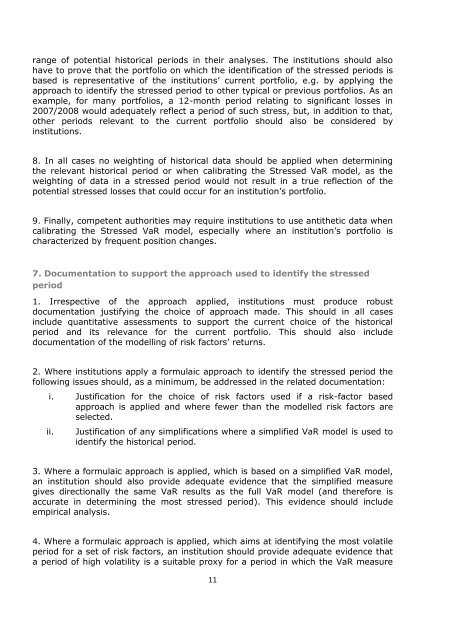EBA Guidelines on Stressed Value At Risk (Stressed VaR) EBA/GL ...
EBA Guidelines on Stressed Value At Risk (Stressed VaR) EBA/GL ...
EBA Guidelines on Stressed Value At Risk (Stressed VaR) EBA/GL ...
Create successful ePaper yourself
Turn your PDF publications into a flip-book with our unique Google optimized e-Paper software.
ange of potential historical periods in their analyses. The instituti<strong>on</strong>s should alsohave to prove that the portfolio <strong>on</strong> which the identificati<strong>on</strong> of the stressed periods isbased is representative of the instituti<strong>on</strong>s’ current portfolio, e.g. by applying theapproach to identify the stressed period to other typical or previous portfolios. As anexample, for many portfolios, a 12-m<strong>on</strong>th period relating to significant losses in2007/2008 would adequately reflect a period of such stress, but, in additi<strong>on</strong> to that,other periods relevant to the current portfolio should also be c<strong>on</strong>sidered byinstituti<strong>on</strong>s.8. In all cases no weighting of historical data should be applied when determiningthe relevant historical period or when calibrating the <strong>Stressed</strong> <strong>VaR</strong> model, as theweighting of data in a stressed period would not result in a true reflecti<strong>on</strong> of thepotential stressed losses that could occur for an instituti<strong>on</strong>’s portfolio.9. Finally, competent authorities may require instituti<strong>on</strong>s to use antithetic data whencalibrating the <strong>Stressed</strong> <strong>VaR</strong> model, especially where an instituti<strong>on</strong>’s portfolio ischaracterized by frequent positi<strong>on</strong> changes.7. Documentati<strong>on</strong> to support the approach used to identify the stressedperiod1. Irrespective of the approach applied, instituti<strong>on</strong>s must produce robustdocumentati<strong>on</strong> justifying the choice of approach made. This should in all casesinclude quantitative assessments to support the current choice of the historicalperiod and its relevance for the current portfolio. This should also includedocumentati<strong>on</strong> of the modelling of risk factors’ returns.2. Where instituti<strong>on</strong>s apply a formulaic approach to identify the stressed period thefollowing issues should, as a minimum, be addressed in the related documentati<strong>on</strong>:i. Justificati<strong>on</strong> for the choice of risk factors used if a risk-factor basedapproach is applied and where fewer than the modelled risk factors areselected.ii.Justificati<strong>on</strong> of any simplificati<strong>on</strong>s where a simplified <strong>VaR</strong> model is used toidentify the historical period.3. Where a formulaic approach is applied, which is based <strong>on</strong> a simplified <strong>VaR</strong> model,an instituti<strong>on</strong> should also provide adequate evidence that the simplified measuregives directi<strong>on</strong>ally the same <strong>VaR</strong> results as the full <strong>VaR</strong> model (and therefore isaccurate in determining the most stressed period). This evidence should includeempirical analysis.4. Where a formulaic approach is applied, which aims at identifying the most volatileperiod for a set of risk factors, an instituti<strong>on</strong> should provide adequate evidence thata period of high volatility is a suitable proxy for a period in which the <strong>VaR</strong> measure11
















